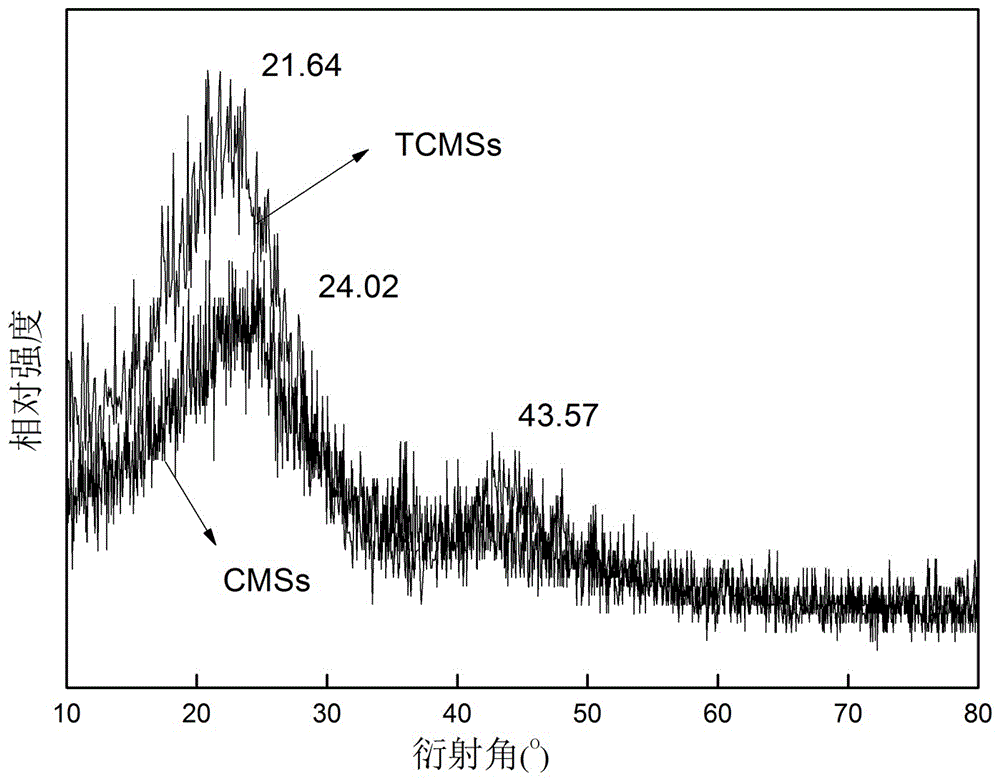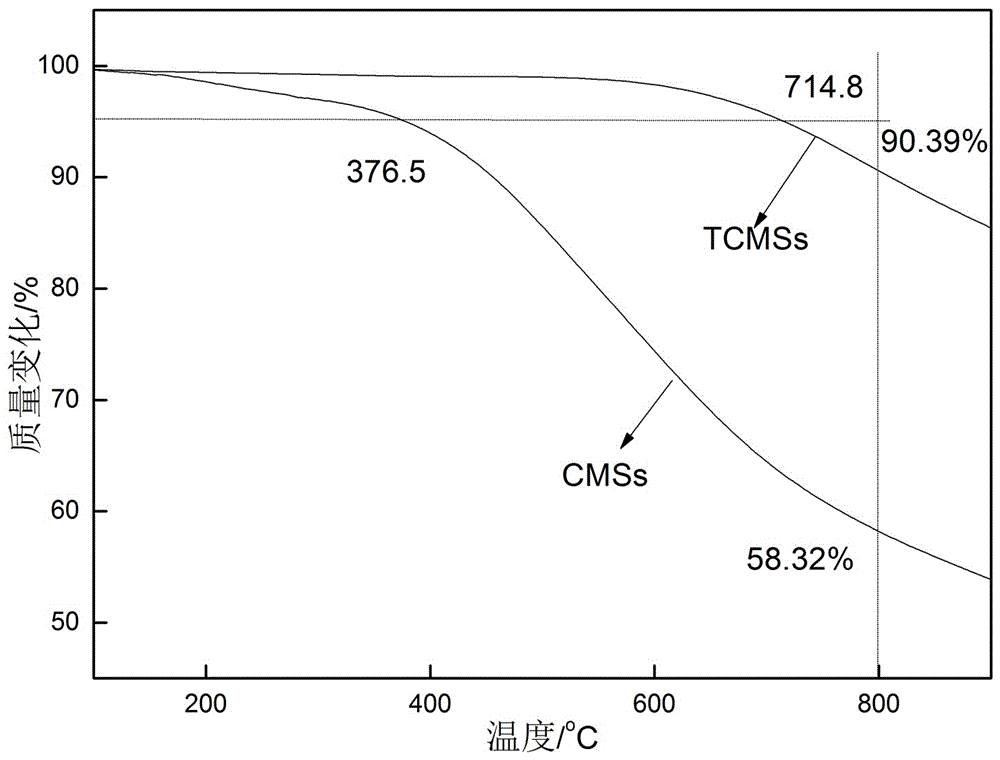Flame-resistant PET composite and preparation method thereof
A composite material and feeding port technology, applied in the manufacture of fire-resistant and flame-retardant filaments, single-component polyester artificial filaments, etc., can solve the problems of many by-products, low decomposition temperature, unfavorable industrial production, etc., and achieve by-product Less, the effect of improving the thermal stability of the product
- Summary
- Abstract
- Description
- Claims
- Application Information
AI Technical Summary
Problems solved by technology
Method used
Image
Examples
Embodiment 1
[0028] Weigh 5g of CMSs into a quartz boat, place the quartz boat in a closed tubular muffle furnace, and first pass nitrogen gas for 10 minutes to replace and drive off the air in the muffle furnace. Keep the nitrogen flow rate at 150ml / min, raise the temperature of the muffle furnace to 800°C at a heating rate of 10°C / min, and keep the constant temperature for 2h. After the reaction, the temperature was naturally lowered to room temperature under a nitrogen atmosphere, and the product was collected to obtain annealed CMSs (ie, TCMSs).
[0029] figure 1 The XRD patterns of the raw CMSs and the annealed TCMSs are given respectively. It can be seen from the figure that CMSs has a broad diffraction peak at 22.83°, indicating that CMSs mainly exists in the form of amorphous carbon. After annealing, the diffraction peak of TCMSs at 21.64° narrows, and another diffraction peak appears at 43.57°. Both are characteristic peaks of graphitic carbon. The relative intensity and peak w...
Embodiment 2
[0042] Weigh 5g of CMSs into a quartz boat, place the quartz boat in a closed tubular muffle furnace, and first pass nitrogen gas for 20 minutes to replace and drive off the air in the muffle furnace. Keep the nitrogen flow rate at 200ml / min, raise the temperature of the muffle furnace to 600°C at a heating rate of 20°C / min, and keep the constant temperature for 5h. After the reaction, the temperature was naturally cooled to room temperature under a nitrogen atmosphere, and the product was collected to obtain annealed CMSs (ie, TCMSs).
[0043] Weigh 1 kg of PET slices, and dry them under vacuum at 130° C. for 8 hours, so that the moisture content of the slices reaches 28 ppm. Weigh 10 g of TCMSs, and also dry it under vacuum at 130° C. for 5 h. Add the dried PET slices to the main feed port of the twin-screw extruder with a frequency of 10Hz, add 10g TCMSs to the side feed port with a frequency of 7Hz, heat to 265°C for melt blending, wire drawing and pelletizing, and obtain...
Embodiment 3
[0046] Weigh 10 g of CMSs into a quartz boat, place the quartz boat in a closed tubular muffle furnace, and first pass nitrogen gas for 20 minutes to replace and remove the air in the muffle furnace. Keep the nitrogen flow rate at 200ml / min, raise the temperature of the muffle furnace to 700°C at a heating rate of 50°C / min, and keep the constant temperature for 3h. After the reaction, the temperature was naturally cooled to room temperature under a nitrogen atmosphere, and the product was collected to obtain annealed CMSs (ie, TCMSs).
[0047] Weigh 1 kg of PET slices, and dry them under vacuum at 130° C. for 8 hours, so that the moisture content of the slices reaches 28 ppm. Weigh 20g of TCMSs, and also dry it in vacuum at 130°C for 8h. Add the dried PET chips to the main feed port of the twin-screw extruder with a frequency of 13Hz, add 20g TCMSs to the side feed port with a frequency of 9Hz, heat to 275°C for melt blending, wire drawing and pelletizing, and obtain TCMSs / P...
PUM
| Property | Measurement | Unit |
|---|---|---|
| particle diameter | aaaaa | aaaaa |
| limiting oxygen index | aaaaa | aaaaa |
Abstract
Description
Claims
Application Information
 Login to View More
Login to View More - R&D
- Intellectual Property
- Life Sciences
- Materials
- Tech Scout
- Unparalleled Data Quality
- Higher Quality Content
- 60% Fewer Hallucinations
Browse by: Latest US Patents, China's latest patents, Technical Efficacy Thesaurus, Application Domain, Technology Topic, Popular Technical Reports.
© 2025 PatSnap. All rights reserved.Legal|Privacy policy|Modern Slavery Act Transparency Statement|Sitemap|About US| Contact US: help@patsnap.com



